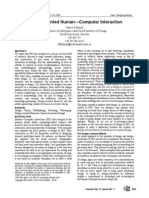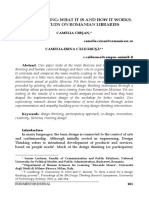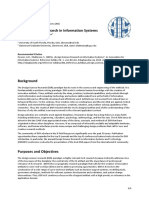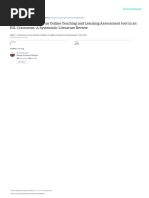Value Sensitive Design As A Formative Framework
Uploaded by
elf2332elfValue Sensitive Design As A Formative Framework
Uploaded by
elf2332elfEthics and Information Technology (2021) 23:39–44
https://doi.org/10.1007/s10676-021-09579-x
ORIGINAL PAPER
Value sensitive design as a formative framework
David G. Hendry1 · Batya Friedman1 · Stephanie Ballard1
Accepted: 13 January 2021 / Published online: 26 February 2021
© The Author(s) 2021
Abstract
In this article, we first offer a model of design knowledge types (know-about, know-that, know-how) and their interrelation-
ships in value sensitive design. Then we demonstrate that value sensitive design is a formative framework, which provides
a shaping influence on practice, enables creative appropriation, and supports theory and method development.
Keywords Design knowledge · Design method · Design model · Design theory · Formative framework · Skillful practice ·
Value sensitive design
While value sensitive design can be considered to be many We shall see that value sensitive design is a formative
things—a perspective for exploring the human-technology framework (Rasmussen 1997; Vicente 1999), a framework
relationship, a theory of design, a methodology, a set of that bounds and guides design processes. It frames and
design tools, a community of practice, a field of research—it nudges, prompting designers to attend to value-oriented
is surely a design framework. When employing value sen- aspects of design situations and to pursue certain kinds of
sitive design in projects, designers bring together concep- work. In short, value sensitive design places a distinctive
tual, empirical, and technical investigations (e.g., Friedman shaping influence on designers. Formative frameworks dif-
2004; Davis and Nathan 2014; Friedman et al. 2017; Fried- fer in purpose from prescriptive ones, which prescribe that
man and Hendry 2019). The process unfolds in a manner certain steps be followed to frame a design problem and to
that is responsive to the design situation. By systematically arrive at a solution. The IEEE P7000 standard, under devel-
accounting for human values during design, tools and tech- opment at the time of writing, is an example of a prescriptive
nologies can be designed that lead to greater good and lesser framework because specific methods for considering moral
harm (for a thorough discussion of this central motivating and ethical concerns are embedded within a waterfall model
proposition of value sensitive design, see Van den Hoven for software development (IEEE Standards Association
2013). 2016; see also Spiekermann 2015). Formative frameworks
Given this dynamic unfolding, what kind of design frame- also differ in purpose from descriptive frameworks, which
work is value sensitive design? We engage this question, describe how design processes unfold and the practices and
first, to clarify the possibilities for taking up, appropriating, skills of designers and other participating stakeholders.
and extending value sensitive design and, second, to take a One example of a descriptive framework can be found in
step toward developing a critical vocabulary for examining value levers (Shilton 2012), which document and describe
varied approaches to technology, human values, and design. common aspects of design situations that cause designers
to pause and reflect on values and issues of ethical import.1
* David G. Hendry
dhendry@uw.edu
Batya Friedman
batya@uw.edu 1
Descriptive, prescriptive, and formative design frameworks are
Stephanie Ballard each valuable on their own terms, and might be complementary in
ballard4@uw.edu purpose. For example, in the service of improving value sensitive
design’s formative framework descriptive studies of value sensitive
1
The Value Sensitive Design Lab, The Information School, design in practice could help to identify misunderstandings, inno-
University of Washington, Mary Gates Hall, Suite 370, vative appropriation, and new opportunities for theory and method
Box 352840, Seattle, WA 98195‑2840, USA development.
13
Vol.:(0123456789)
Content courtesy of Springer Nature, terms of use apply. Rights reserved.
40 D. G. Hendry et al.
A model of design knowledge in value
sensitive design
To clarify the dynamics of value sensitive design and
uncover its formative structure, we present the following
model which distinguishes three types of design knowl-
edge—know-about (theory), know-that (translation), and
know-how (method)—and their interrelationships (see
Fig. 1 and Table 1). Within each knowledge type and with
an eye toward enacting design, we further identify rel-
evant knowledge elements. We then consider how these
knowledge types and elements work together as a forma-
tive framework.
Intended to be an working expository sketch, this model
is consistent with authoritative accounts (Friedman 2004;
Davis and Nathan 2014; Friedman et al. 2017; Friedman
and Hendry 2019). As with other design perspectives (Pye
1978; Winograd and Flores 1986; Schön 1987; Nelson and
Stolterman 2012), value sensitive design integrates theo-
retical and practical knowledge, with each responsive to
the design situation. By theoretical knowledge we mean Fig. 1 Through translational processes, theory and practice mutually
inform and shape each other; each responsive to the design situation
broad, general concepts that are widely applicable across
particular design situations. By practical knowledge we
mean design skill, intuition, experience, judgement, and are more broadly affected by the technology. As societies
wisdom, characteristic of master craftsmen and reflective evolve, as literature and discourse develops, and as value
practitioners. While the model surely raises new ques- sensitive design projects are completed and reflected upon,
tions—for example, what are the forms of practical, theo- the theoretical constructs develop too. Current discussion of
retical, and translational knowledge; how do these forms systemic racism in the United States, for example, leads to
of knowledge integrate and support mutually deep inquiry; consideration of stakeholders not only by role (e.g., direct
how are heuristics related to theory and methods; how are and indirect stakeholder) but also by individual or commu-
project-specific theory-to-practice commitments formed, nity identity. Similarly, developing discussions worldwide
and so forth—its aim is to present illustrative knowledge of the moral standing of non-human beings (e.g., clams,
types of value sensitive design and their interrelationships, wolves, rivers, mountains, stars) leads to consideration of
concisely and comprehensibility. Given our primary pur- non-human stakeholders and associated theory.
pose, namely to demonstrate how value sensitive design
is a formative framework, in Table 1 in addition to the Next is translation
three knowledge types, we include six exemplary knowl-
edge elements. The theory-to-practice commitments are framing and shap-
ing constraints that aid in translation, that guide designers in
Beginning with theory planning their design processes and unfolding work. Meta-
phorically, theory-to-practice commitments are analogous
The theoretical constructs, the foundation of value sensitive to: a grammar that represents a language but not particular
design, are well-chosen abstractions, propositions or per- sentences; a morphological analysis of a class of objects
spectives, carefully defined and explicated for considering but no single object; or a social policy that is intended to
design situations—the know-about knowledge that needs to lead to desired ends but does not stipulate specific means.
be engaged. Distilled from the philosophical, social science, Theory-to-practice commitments, simply put, translate
and technical literatures and informed by practical experi- the theoretical constructs into action-oriented statements
ence, the theoretical constructs characterize how values for moving forward. Responsive to the design situation,
are implicated in design processes. To illustrate, one theo- these commitments are largely declarative. They embody
retical construct demarcates the distinction between direct know-that (what needs attending to) but not know-how (the
stakeholders, those who interact directly with a technology skills, intuitions, and knowledge of practical action) (Ryle
under consideration, and indirect stakeholders, those who 1945–1946; Schön 1987, p. 22). For example, following the
13
Content courtesy of Springer Nature, terms of use apply. Rights reserved.
Value sensitive design as a formative framework 41
Table 1 Model of types of design knowledge and their interrelation- lational processes operate in both directions, from theory-to-practice
ships in value sensitive design, with (reading from bottom to top) the- and from practice-to-theory
ory providing a foundation for contextualized, in situ practice. Trans-
Knowledge Definition Knowledge Example
Element of Element Type
Heuristic Guidance for selecting, Know-how - Conduct stakeholder
ordering, and managing analysis early
value-oriented design - Prioritize which
processes stakeholders to emphasize
and which to set aside
given resource constraints
Method Focused activity Know-how -Direct and indirect
Practice intended to uncover or stakeholder analysis
develop particular kinds -Stakeholder tokens
of value-oriented design
insights or directions
Toolkit Physical and digital Know-how The “stakeholder” cards in
materials that support the Envisioning Cards
value sensitive design toolkit
investigations and
methods
Practice-to-Theory Delineated empirical Know-that Stakeholders who hold to
Commitment accounts from practice individual or community
that translate into identity provide empirical
specific refinements, insights and reasons to
extensions or additions broaden the theoretical
to the theoretical construct of stakeholders to
constructs and directs account for identity in
innovation in theory addition to role
Translation
Theory-to-Practice Declarative statements Know-that Interests of direct and
Commitment that translate the indirect stakeholders must
theoretical constructs be addressed
into actionable value-
oriented project steps or
design processes
Theoretical Abstractions, Know-about Direct and indirect
Construct propositions, or stakeholders are impacted
perspectives, carefully by technology
Theory defined and explicated
for value-oriented
framing and
consideration of design
situations
13
Content courtesy of Springer Nature, terms of use apply. Rights reserved.
42 D. G. Hendry et al.
theoretical construct distinguishing between direct and indi- fit within existing theory as, for example, would be the case
rect stakeholders, the theory-to-practice commitment is to of identifying a new indirect-stakeholder role. However, in
legitimate both direct and indirect stakeholders and bring other cases, empirical data or other design work will stretch
their interests, including an analysis of potential harms and existing theory or problematize it. In such cases, a gap in
benefits, into the design process. However, exactly how to theory might be exposed which, in turn, offers opportuni-
engage with direct and indirect stakeholders is left to other ties for refining or extending existing theoretical constructs
knowledge elements. As a matter of generally expected prac- or for inventing new ones. For example, the development of
tice, the theory-to-practice commitments have a normative new policies, laws or social norms related to identity have
quality, establishing a firm point of view for guiding action pointed to limitations with stakeholder analyses based solely
without prescribing particular procedures or checklists. on roles. Generally, to maintain the integrity of the theoreti-
cal foundation, changes or additions to theory are narrow,
Now to practice targeted and made judiciously.
(We shall return to the practice-to-theory commitment Stepping back
shortly.) The heuristics, methods, and toolkits are knowledge
elements that represent some aspects of skillful practice. Value sensitive design, in its entirety, is directed toward tak-
Notably, there could be many more here. In contrast to the ing action in “design situations” (Nelson and Stolterman
theoretical constructs and theory-to-practice commitments, 2012; Schön 1987), typically characterized ecologically,
the heuristics, methods, and toolkits focus on know-how, by complexity and uncertainty, and comprising all the cul-
that is, taking action and doing things in the design situation. tural, environmental, legal, political, social, and technical
To select and employ a toolkit or method well means elements that bear on or support design. Skillful practice,
to be faithful to the theory-to-practice commitments. Being seen broadly as drawing on experience, artistry, and wisdom,
faithful does not refer to some kind of easily recognized con- infuses the entire model.
formance. Instead, it means a genuine critical engagement
with the commitments, seeking to explicate their meaning
and use, or perhaps non-use. Thus, for example, to identify Value sensitive design as a formative
and to legitimate the direct and indirect stakeholders in a framework
design project, many different toolkits or empirical or ana-
lytic methods might be employed, depending on the design With this model in hand, we now return to our question:
situation. Two examples are the Envisioning Cards toolkit What kind of framework is value sensitive design? And
with its stakeholder card suit and the stakeholder tokens to our response: A formative one. The term “formative”
method (Yoo 2018; Friedman and Hendry 2019). emphasizes a certain kind of influence on skillful practice,
Complementing methods and toolkits, to support design namely a guiding or shaping influence within bounds, with
practice are heuristics. Specifically, heuristics emphasize flexible constraints and without prescriptions. As we have
strategies and nuance to be applied in and across methods seen, the translational theory-to-practice and practice-to-the-
and toolkits. Among other things, heuristics are useful in ory commitments embody this shaping influence by nudging
planning, and for considering how to adjust design processes designers toward certain kinds of framings and modes of
as the design situation is engaged. For example, “To get inquiry; so too with the heuristics, methods and toolkits.
started on a new project, it is often useful to conduct a con- But no rigid step-by-step procedures are prescribed—the
ceptual analysis of direct and indirect stakeholders." Heuris- sequence of actions is left up to the designers as they engage
tics arise largely from reflections on skillful practice, during with the design situation, including stakeholders.
or after projects, along with studies of projects reported in One benefit of the formative influence of the value sensi-
the literature, conversations with designers, and so on. tive design framework is that it positions designers to be
sensitive to values, noting that sensitive refers to a designer
Returning to translation who is engaging with values in the full complexity of the
design situation and who is seeking good overall solutions,
For the practice-to-theory commitment, taking action in the not perfect ones. Relatedly, because the value sensitive
design situation—through empirical, technical or concep- design framework does not represent design procedurally,
tual investigations—will likely lead to unexpected findings with specified inputs and outputs at each step, it lends itself
and new insights. The practice-to-theory knowledge element to creative appropriation, no matter the application domain.
marks the shaping influence of situated, practical experience This flexibility, however, does come with added opportunity
on theory. Given a routine or at least fairly well-understood and responsibility.
design situation, the particulars of design work will readily
13
Content courtesy of Springer Nature, terms of use apply. Rights reserved.
Value sensitive design as a formative framework 43
Another benefit of the formative structure is that value of different approaches to technology, human values, and
sensitive design is both stable and also open to revision; it design.
can organically absorb expansion, adjustment and adapta- Lastly, we observe: To be useful, a design approach
tion. In particular, the separation of the theoretical constructs needs to strike a meaningful balance between openness
from the translational commitments offers the framework and specificity. An approach that is too open leaves design-
stability and integrity while enabling ongoing development. ers with insufficient practical guidance for which type of
For example, new and original theory-to-practice commit- design knowledge (know-about, know-that, and know-how)
ments might be derived from the theoretical constructs. to apply, and when and how to apply it. An approach that is
Or, specialized theory-to-practice commitments related to too specific runs the risk of prescribing design actions that
a particular project might be developed. Or, a theoretical do not adequately account for the unique realities of each
construct might be problematized in a practice-to-theory design situation and, in turn, might result in designs that
commitment and further developed. In each case, this work ultimately do more harm than good. Value sensitive design
can be done without destabilizing the overall integrity of has long sought such a robust, sensitive balance.
the framework.
Acknowledgements Our sincere thanks to Jason Millar for stimulating
discussion and written comments and to the reviewers whose careful
reading and comments helped us improve this article.
Conclusion
Open Access This article is licensed under a Creative Commons Attri-
In summary, we have demonstrated that, like a compass bution 4.0 International License, which permits use, sharing, adapta-
which offers a reliable orientation for moving forward tion, distribution and reproduction in any medium or format, as long
as you give appropriate credit to the original author(s) and the source,
in vaguely understood terrain, value sensitive design is a provide a link to the Creative Commons licence, and indicate if changes
dependable framework for design situations, which are typi- were made. The images or other third party material in this article are
cally complex and uncertain. Key to understanding the form- included in the article’s Creative Commons licence, unless indicated
ative dynamics of value sensitive design are the knowledge otherwise in a credit line to the material. If material is not included in
the article’s Creative Commons licence and your intended use is not
types, their interrelationships, and their shaping influence. permitted by statutory regulation or exceeds the permitted use, you will
Recall that the purpose of Table 1 is to make some working need to obtain permission directly from the copyright holder. To view a
distinctions so as to clarify how value sensitive design is copy of this licence, visit http://creativecommons.org/licenses/by/4.0/.
a formative framework. That said, ultimately, we think of
value sensitive design as part art and part science with rich
intricacy that currently defies full expression. As a counter- References
point to the precision of Table 1, recall Fig. 1 which conveys
the ineffable integration of theory and practice. Inquiry into Davis, J., & Nathan, L. P. (2014). Value sensitive design: Applications,
adaptations, and critiques. In J. van den Hoven, P. E. Vermaas, &
the knowledge of design, and specifically the knowledge of I. van de Poel (Eds.), Handbook of ethics, values, and technologi-
value sensitive design, is a continuing opportunity, indeed, cal design (pp. 1–26). New York: Springer.
a grand challenge. Friedman, B., Hendry, D. G., & Borning, A. (2017). A survey of value
Of many directions for further inquiry, one immediate sensitive design methods. Foundations and Trends in Human-
Computer Interaction, 11(23), 63–125.
implication concerns theory-to-practice commitments: What Friedman, B., & Hendry, D. G. (2019). Value sensitive design: Shaping
theory-to-practice commitments, even if implicitly, are regu- technology with moral imagination. Cambridge, MA: MIT Press.
larly used in value sensitive design projects? How, if at all, Friedman, B. (2004). Value sensitive design. In W. S. Bainbridge (Ed.),
do designers develop such commitments, particularize them Berkshire encyclopedia of human-computer interaction (pp. 769–
774). Great Barrington, MA: Berkshire Publishing Group.
for design situations, and link them to the theoretical con- Hoven, J. van den (2013). Value sensitive design and responsible inno-
structs? How do these commitments come to shape design vation. In R. Owen, J. Bessant, & M. Heintz (Eds.), Responsible
processes? In a different vein, this model might be helpful innovation (pp. 75–83). Hoboken, NJ: John Wiley & Sons.
for learning about value sensitive design, as it provides a IEEE Standards Association. (2016). P7000 - model process for
addressing ethical concerns during system design. Retrieved from
guide for reading authoritative accounts or for scrutinizing http://standards.ieee.org/develop/project/7000.html.
research papers. We would expect such inquiry to lead to Nelson, H. G., & Stolterman, E. (2012). The design way: Intentional
elaboration and expansion of the model. change in an unpredictable world (2nd ed.). Cambridge, MA:
Looking to the future, one way to further develop value The MIT Press.
Pye, D. (1978). The nature and aesthetics of design. London: The Her-
sensitive design would be to identify useful concepts about bert Press.
the framework itself, that is, meta-concepts. The idea that Rasmussen, J. (1997). Merging paradigms: Decision making, manage-
value sensitive design is a formative framework is one such ment, and cognitive control. In R. Flin, E. Salas, M. Strub, & L.
meta-concept. Once identified and explicated, meta-concepts Mai (Eds.), Decision making under stress: Emerging themes and
applications (pp. 67–81). Brookfield, VT: Ashgate.
might be used to investigate the characteristics and merits
13
Content courtesy of Springer Nature, terms of use apply. Rights reserved.
44 D. G. Hendry et al.
Ryle, G. (1945–1946). Knowing how and knowing that: The presiden- Winograd, T., & Flores, F. (1986). Understanding computers and cog-
tial address. Proceedings of the Aristotelian Society, 1945–1946, nition: A new foundation for design. Boston: Addison-Wesley.
46, 1–16. Yoo, D. (2018). Stakeholder Tokens: A constructive method
Schön, D. A. (1987). Educating the reflective practitioner: Toward for value sensitive design stakeholder analysis. Ethics and
a new design for teaching and learning in the professions. San Information Technology. https : //doi.org/10.1007/s1067
Francisco, CA: Jossey-Bass. 6-018-9474-4.
Shilton, K. (2012). Value levers: Building ethics into design. Science,
Technology, & Human Values, 38(3), 374–397. Publisher’s Note Springer Nature remains neutral with regard to
Spiekermann, S. (2015). Ethical IT innovation: A value-based system jurisdictional claims in published maps and institutional affiliations.
design approach. Boca Raton, FL: Auerbach Publications.
Vicente, K. (1999). Cognitive work analysis: Toward safe, productive,
and healthy computer-based work. New York: Taylor & Francis.
13
Content courtesy of Springer Nature, terms of use apply. Rights reserved.
Terms and Conditions
Springer Nature journal content, brought to you courtesy of Springer Nature Customer Service Center GmbH (“Springer Nature”).
Springer Nature supports a reasonable amount of sharing of research papers by authors, subscribers and authorised users (“Users”), for small-
scale personal, non-commercial use provided that all copyright, trade and service marks and other proprietary notices are maintained. By
accessing, sharing, receiving or otherwise using the Springer Nature journal content you agree to these terms of use (“Terms”). For these
purposes, Springer Nature considers academic use (by researchers and students) to be non-commercial.
These Terms are supplementary and will apply in addition to any applicable website terms and conditions, a relevant site licence or a personal
subscription. These Terms will prevail over any conflict or ambiguity with regards to the relevant terms, a site licence or a personal subscription
(to the extent of the conflict or ambiguity only). For Creative Commons-licensed articles, the terms of the Creative Commons license used will
apply.
We collect and use personal data to provide access to the Springer Nature journal content. We may also use these personal data internally within
ResearchGate and Springer Nature and as agreed share it, in an anonymised way, for purposes of tracking, analysis and reporting. We will not
otherwise disclose your personal data outside the ResearchGate or the Springer Nature group of companies unless we have your permission as
detailed in the Privacy Policy.
While Users may use the Springer Nature journal content for small scale, personal non-commercial use, it is important to note that Users may
not:
1. use such content for the purpose of providing other users with access on a regular or large scale basis or as a means to circumvent access
control;
2. use such content where to do so would be considered a criminal or statutory offence in any jurisdiction, or gives rise to civil liability, or is
otherwise unlawful;
3. falsely or misleadingly imply or suggest endorsement, approval , sponsorship, or association unless explicitly agreed to by Springer Nature in
writing;
4. use bots or other automated methods to access the content or redirect messages
5. override any security feature or exclusionary protocol; or
6. share the content in order to create substitute for Springer Nature products or services or a systematic database of Springer Nature journal
content.
In line with the restriction against commercial use, Springer Nature does not permit the creation of a product or service that creates revenue,
royalties, rent or income from our content or its inclusion as part of a paid for service or for other commercial gain. Springer Nature journal
content cannot be used for inter-library loans and librarians may not upload Springer Nature journal content on a large scale into their, or any
other, institutional repository.
These terms of use are reviewed regularly and may be amended at any time. Springer Nature is not obligated to publish any information or
content on this website and may remove it or features or functionality at our sole discretion, at any time with or without notice. Springer Nature
may revoke this licence to you at any time and remove access to any copies of the Springer Nature journal content which have been saved.
To the fullest extent permitted by law, Springer Nature makes no warranties, representations or guarantees to Users, either express or implied
with respect to the Springer nature journal content and all parties disclaim and waive any implied warranties or warranties imposed by law,
including merchantability or fitness for any particular purpose.
Please note that these rights do not automatically extend to content, data or other material published by Springer Nature that may be licensed
from third parties.
If you would like to use or distribute our Springer Nature journal content to a wider audience or on a regular basis or in any other manner not
expressly permitted by these Terms, please contact Springer Nature at
onlineservice@springernature.com
You might also like
- Intersections in Design Thinking and Art ThinkingNo ratings yetIntersections in Design Thinking and Art Thinking22 pages
- Exploring trait factors associated with design thinking disposition in young adults A fuzzy set qualitative comparative analysis fsQCANo ratings yetExploring trait factors associated with design thinking disposition in young adults A fuzzy set qualitative comparative analysis fsQCA26 pages
- Design and Development Research: Rita C. Richey and James D. KleinNo ratings yetDesign and Development Research: Rita C. Richey and James D. Klein10 pages
- Design Oriented Human Computer Interaction - 2No ratings yetDesign Oriented Human Computer Interaction - 28 pages
- Design Thinking in Education Perspectives Opportun0% (1)Design Thinking in Education Perspectives Opportun26 pages
- 50 ADIM2019 - Design Thinking Mindset - Consultancy Sobel Et AlNo ratings yet50 ADIM2019 - Design Thinking Mindset - Consultancy Sobel Et Al7 pages
- Design Thinking - An Educational Model Towards Creative ConfidenceNo ratings yetDesign Thinking - An Educational Model Towards Creative Confidence9 pages
- Inspirational Patterns For Embodied Interaction: Spirational Patterns, or I-Patterns, Which Refers ToNo ratings yetInspirational Patterns For Embodied Interaction: Spirational Patterns, or I-Patterns, Which Refers To9 pages
- A Proposal For A Formal Definition of The Design ConceptNo ratings yetA Proposal For A Formal Definition of The Design Concept26 pages
- Legitimating Design A Sociology of Knowledge AccouNo ratings yetLegitimating Design A Sociology of Knowledge Accou21 pages
- Strong Concepts: Intermediate-Level Knowledge in Interaction Design ResearchNo ratings yetStrong Concepts: Intermediate-Level Knowledge in Interaction Design Research18 pages
- The Core of Design Thinking' and Its Application: Rowe, 1987No ratings yetThe Core of Design Thinking' and Its Application: Rowe, 198712 pages
- J of Product Innov Manag - 2014 - Liedtka - Perspective Linking Design Thinking With Innovation Outcomes Through CognitiveNo ratings yetJ of Product Innov Manag - 2014 - Liedtka - Perspective Linking Design Thinking With Innovation Outcomes Through Cognitive14 pages
- [P] BADKE-SCHAUB 2018 - Design Methodology Where Do You GoNo ratings yet[P] BADKE-SCHAUB 2018 - Design Methodology Where Do You Go8 pages
- (Educational Communications and Technology_ Issues and Innovations) Monica W. Tracey, John Baaki (Auth.), Brad Hokanson, Andrew Gibbons (Eds.)-Design in Educational Technology_ Design Thinking, Design100% (2)(Educational Communications and Technology_ Issues and Innovations) Monica W. Tracey, John Baaki (Auth.), Brad Hokanson, Andrew Gibbons (Eds.)-Design in Educational Technology_ Design Thinking, Design277 pages
- Evolutionary Design: Philosophy, Theory, and Application TacticsNo ratings yetEvolutionary Design: Philosophy, Theory, and Application Tactics6 pages
- Design Thinking - A Method or A Gateway Into Design CognitionNo ratings yetDesign Thinking - A Method or A Gateway Into Design Cognition6 pages
- The Nature of Design Practice and ImplicationsNo ratings yetThe Nature of Design Practice and Implications22 pages
- Chantzaras 2018 ArchitectureasSystemDesignInnovationDesignDiscipline WorkingPaperNo ratings yetChantzaras 2018 ArchitectureasSystemDesignInnovationDesignDiscipline WorkingPaper17 pages
- Dorst, There Is No Such Thing As Strategic Design, 2023No ratings yetDorst, There Is No Such Thing As Strategic Design, 202321 pages
- 61 Greene Design Thinking Vs Systems Thinking For Engineering Desgin What S The Difference 1No ratings yet61 Greene Design Thinking Vs Systems Thinking For Engineering Desgin What S The Difference 110 pages
- 2010 - A Wodehouse, Information Use in Conceptual Design, Existing Taxonomies and New Approaches - International Journal of DesignNo ratings yet2010 - A Wodehouse, Information Use in Conceptual Design, Existing Taxonomies and New Approaches - International Journal of Design13 pages
- 1-s2.0-S0142694X21000880-main Question 3aNo ratings yet1-s2.0-S0142694X21000880-main Question 3a21 pages
- Carlgren Et Al, 2016, Framing Design ThinkingNo ratings yetCarlgren Et Al, 2016, Framing Design Thinking21 pages
- Interior Design Concept - Critical Practices, Processes and - Natalie Badenduck - 2022 - Routledge - 9781032080277 - Anna's ArchiveNo ratings yetInterior Design Concept - Critical Practices, Processes and - Natalie Badenduck - 2022 - Routledge - 9781032080277 - Anna's Archive212 pages
- Design & Creativity Thinking - DR ChuķwuìgweNo ratings yetDesign & Creativity Thinking - DR Chuķwuìgwe9 pages
- AIS Reference Syllabus Design Science Research in ISNo ratings yetAIS Reference Syllabus Design Science Research in IS9 pages
- Editorial Challenging Design Based Research 44rf456qrdNo ratings yetEditorial Challenging Design Based Research 44rf456qrd13 pages
- What Is Design Thinking and Why Is It Important-11-19No ratings yetWhat Is Design Thinking and Why Is It Important-11-199 pages
- Design, When Everybody Designs: An Introduction to Design for Social InnovationFrom EverandDesign, When Everybody Designs: An Introduction to Design for Social InnovationNo ratings yet
- Taking [A]part: The Politics and Aesthetics of Participation in Experience-Centered DesignFrom EverandTaking [A]part: The Politics and Aesthetics of Participation in Experience-Centered DesignNo ratings yet
- Scientometric Analysis On Infertility Literature: An Indian PerspectiveNo ratings yetScientometric Analysis On Infertility Literature: An Indian Perspective7 pages
- Fuzzy Assisted Human Resource Management For SupplNo ratings yetFuzzy Assisted Human Resource Management For Suppl3 pages
- Maximizing Your Research Visibility and Impact: A Step-by-Step Guide Session 5: Boosting The Visibility of The Research - Make A Paper IDNo ratings yetMaximizing Your Research Visibility and Impact: A Step-by-Step Guide Session 5: Boosting The Visibility of The Research - Make A Paper ID82 pages
- Technology For Teaching in The Elementary GradesNo ratings yetTechnology For Teaching in The Elementary Grades8 pages
- List of Search Engine For Research Papers and BooksNo ratings yetList of Search Engine For Research Papers and Books2 pages
- A Literature Collection On Routing in The Internet of Things (Iot) With RPL Part 3: RPL Analysis and EvaluationNo ratings yetA Literature Collection On Routing in The Internet of Things (Iot) With RPL Part 3: RPL Analysis and Evaluation7 pages
- Estimating Potential Soil Sheet Erosion in A BraziNo ratings yetEstimating Potential Soil Sheet Erosion in A Brazi12 pages
- Different Online Tools Used in ResearchNo ratings yetDifferent Online Tools Used in Research12 pages
- Whitty&Power (2000) - Marketization and Privatization in Mass EducationNo ratings yetWhitty&Power (2000) - Marketization and Privatization in Mass Education16 pages
- Surviving Academia As An Early Career Researcher - An Unreliable Guide - Naturejobs BlogNo ratings yetSurviving Academia As An Early Career Researcher - An Unreliable Guide - Naturejobs Blog6 pages
- IAEME Publication Call For Paper February 2024No ratings yetIAEME Publication Call For Paper February 202423 pages
- Value Sensitive Design As A Formative FrameworkNo ratings yetValue Sensitive Design As A Formative Framework7 pages
- Seun Ajayi Paragraphic Letter of MotivationNo ratings yetSeun Ajayi Paragraphic Letter of Motivation2 pages
- The Work Stress Questionnaire WSQ - Reliability AnNo ratings yetThe Work Stress Questionnaire WSQ - Reliability An9 pages
- the-use-of-quizizz-as-an-online-teaching-and-learning-assessment-tool-in-an-esl-classroom-a-systematic-literature-reviewNo ratings yetthe-use-of-quizizz-as-an-online-teaching-and-learning-assessment-tool-in-an-esl-classroom-a-systematic-literature-review20 pages
- Exploring trait factors associated with design thinking disposition in young adults A fuzzy set qualitative comparative analysis fsQCAExploring trait factors associated with design thinking disposition in young adults A fuzzy set qualitative comparative analysis fsQCA
- Design and Development Research: Rita C. Richey and James D. KleinDesign and Development Research: Rita C. Richey and James D. Klein
- Design Thinking in Education Perspectives OpportunDesign Thinking in Education Perspectives Opportun
- 50 ADIM2019 - Design Thinking Mindset - Consultancy Sobel Et Al50 ADIM2019 - Design Thinking Mindset - Consultancy Sobel Et Al
- Design Thinking - An Educational Model Towards Creative ConfidenceDesign Thinking - An Educational Model Towards Creative Confidence
- Inspirational Patterns For Embodied Interaction: Spirational Patterns, or I-Patterns, Which Refers ToInspirational Patterns For Embodied Interaction: Spirational Patterns, or I-Patterns, Which Refers To
- A Proposal For A Formal Definition of The Design ConceptA Proposal For A Formal Definition of The Design Concept
- Legitimating Design A Sociology of Knowledge AccouLegitimating Design A Sociology of Knowledge Accou
- Strong Concepts: Intermediate-Level Knowledge in Interaction Design ResearchStrong Concepts: Intermediate-Level Knowledge in Interaction Design Research
- The Core of Design Thinking' and Its Application: Rowe, 1987The Core of Design Thinking' and Its Application: Rowe, 1987
- J of Product Innov Manag - 2014 - Liedtka - Perspective Linking Design Thinking With Innovation Outcomes Through CognitiveJ of Product Innov Manag - 2014 - Liedtka - Perspective Linking Design Thinking With Innovation Outcomes Through Cognitive
- [P] BADKE-SCHAUB 2018 - Design Methodology Where Do You Go[P] BADKE-SCHAUB 2018 - Design Methodology Where Do You Go
- (Educational Communications and Technology_ Issues and Innovations) Monica W. Tracey, John Baaki (Auth.), Brad Hokanson, Andrew Gibbons (Eds.)-Design in Educational Technology_ Design Thinking, Design(Educational Communications and Technology_ Issues and Innovations) Monica W. Tracey, John Baaki (Auth.), Brad Hokanson, Andrew Gibbons (Eds.)-Design in Educational Technology_ Design Thinking, Design
- Evolutionary Design: Philosophy, Theory, and Application TacticsEvolutionary Design: Philosophy, Theory, and Application Tactics
- Design Thinking - A Method or A Gateway Into Design CognitionDesign Thinking - A Method or A Gateway Into Design Cognition
- Chantzaras 2018 ArchitectureasSystemDesignInnovationDesignDiscipline WorkingPaperChantzaras 2018 ArchitectureasSystemDesignInnovationDesignDiscipline WorkingPaper
- Dorst, There Is No Such Thing As Strategic Design, 2023Dorst, There Is No Such Thing As Strategic Design, 2023
- 61 Greene Design Thinking Vs Systems Thinking For Engineering Desgin What S The Difference 161 Greene Design Thinking Vs Systems Thinking For Engineering Desgin What S The Difference 1
- 2010 - A Wodehouse, Information Use in Conceptual Design, Existing Taxonomies and New Approaches - International Journal of Design2010 - A Wodehouse, Information Use in Conceptual Design, Existing Taxonomies and New Approaches - International Journal of Design
- Interior Design Concept - Critical Practices, Processes and - Natalie Badenduck - 2022 - Routledge - 9781032080277 - Anna's ArchiveInterior Design Concept - Critical Practices, Processes and - Natalie Badenduck - 2022 - Routledge - 9781032080277 - Anna's Archive
- AIS Reference Syllabus Design Science Research in ISAIS Reference Syllabus Design Science Research in IS
- Editorial Challenging Design Based Research 44rf456qrdEditorial Challenging Design Based Research 44rf456qrd
- What Is Design Thinking and Why Is It Important-11-19What Is Design Thinking and Why Is It Important-11-19
- Design, When Everybody Designs: An Introduction to Design for Social InnovationFrom EverandDesign, When Everybody Designs: An Introduction to Design for Social Innovation
- Taking [A]part: The Politics and Aesthetics of Participation in Experience-Centered DesignFrom EverandTaking [A]part: The Politics and Aesthetics of Participation in Experience-Centered Design
- Scientometric Analysis On Infertility Literature: An Indian PerspectiveScientometric Analysis On Infertility Literature: An Indian Perspective
- Fuzzy Assisted Human Resource Management For SupplFuzzy Assisted Human Resource Management For Suppl
- Maximizing Your Research Visibility and Impact: A Step-by-Step Guide Session 5: Boosting The Visibility of The Research - Make A Paper IDMaximizing Your Research Visibility and Impact: A Step-by-Step Guide Session 5: Boosting The Visibility of The Research - Make A Paper ID
- List of Search Engine For Research Papers and BooksList of Search Engine For Research Papers and Books
- A Literature Collection On Routing in The Internet of Things (Iot) With RPL Part 3: RPL Analysis and EvaluationA Literature Collection On Routing in The Internet of Things (Iot) With RPL Part 3: RPL Analysis and Evaluation
- Estimating Potential Soil Sheet Erosion in A BraziEstimating Potential Soil Sheet Erosion in A Brazi
- Whitty&Power (2000) - Marketization and Privatization in Mass EducationWhitty&Power (2000) - Marketization and Privatization in Mass Education
- Surviving Academia As An Early Career Researcher - An Unreliable Guide - Naturejobs BlogSurviving Academia As An Early Career Researcher - An Unreliable Guide - Naturejobs Blog
- The Work Stress Questionnaire WSQ - Reliability AnThe Work Stress Questionnaire WSQ - Reliability An
- the-use-of-quizizz-as-an-online-teaching-and-learning-assessment-tool-in-an-esl-classroom-a-systematic-literature-reviewthe-use-of-quizizz-as-an-online-teaching-and-learning-assessment-tool-in-an-esl-classroom-a-systematic-literature-review

























































































